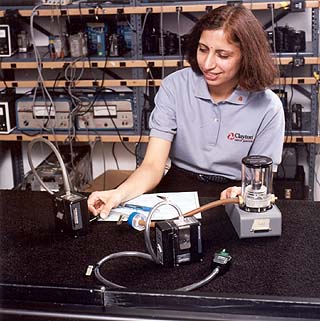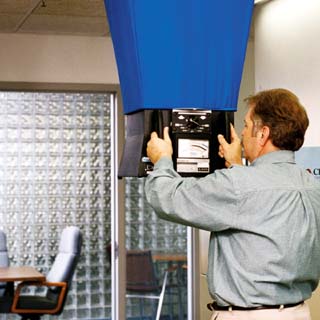
Surveys
DJC.COM
July 17, 2003
Check out properties with microbial surveys
Clayton Group Services

Wolfe
|
Because of lawsuits, large insurance losses, lost real estate deals, property-related stigmas, scare stories, and growing public and regulatory recognition.
As these have raised the general consciousness about health effects related to mold, many banks, lending institutions and law firms are now requesting microbial surveys along with Phase I environmental site assessments (ESAs).
ESA studies determine if a particular property is subject to recognized environmental conditions.
Still, few know what a microbial survey entails and there are currently no laws or regulations governing the process as of May 2003 — though several organizations offer guidance, such as the American Conference of Governmental Industrial Hygienists and American Industrial Hygiene Association.

Photos courtesy of Clayton Group Services
Prior to conducting an indoor air quality investigation, a Clayton technician calibrates a pump.
|
Microbial surveys are often requested in response to concerns about liability. They should provide an appropriate level of inquiry, address the concerns that prompt them, and distinguish real concerns from hype.
Types of assessment
The most common request is for a visual inspection of selected areas. This is simply a screen and not a comprehensive survey.
While screening may find large and significant issues in a cost-effective way, not all issues will always be identified, which is why clients need to understand and weigh cost versus risk. The additional costs of a more thorough assessment can provide greater assurance that significant issues are not missed. This choice will likely be driven by the type of transaction and site-specific issues.
When a more comprehensive survey is warranted, it is advisable to define a specific scope of work and associated costs. Some options are more suitable for inclusion in a standard Phase I ESA, and others are more complex, requiring more experienced consultants at greater cost. The range of indoor air quality related assessments includes:
Visual assessment. Generally considered the primary method for assessing water damage and suspect visible fungal amplification, a limited visual assessment is very appropriate and can be cost-effective in conjunction with a Phase I ESA.
The real question is scope (i.e., how much of the building is actually inspected and at what level of detail), which affects project duration and costs.
A limited visual evaluation typically involves inspecting areas normally encountered during a Phase I ESA. Add-ons may include, for example, a review of building water damage history, and interviews with site operators to determine if there were leaks, floods or other events. Visual assessment is not destructive and does not include sampling.
Visual assessment with limited sampling. Includes the above activities, plus moisture checks of interior finishes with bulk sampling for microbial contaminants. Sampling may be called for when mold has been observed.
This exceeds what would normally be requested with a Phase I ESA, but may be triggered by findings of a visual assessment.
Visual assessment with limited sampling and HVAC evaluation. The above activities, plus evaluation of the HVAC system (i.e., collecting data related to air changes, temperature, humidity and system maintenance).
Indoor air quality (IAQ) assessment. A full scope of work: considering past building use, odor sources, chemicals, special use areas, building pressurization and other potential air contaminants in a building.
A full-blown IAQ assessment includes comprehensive evaluation of HVAC system design, operation and maintenance, as well as current needs as they relate to potential air quality issues. This option may be most attractive to building purchasers.
A comprehensive survey for IAQ and microbial issues can easily be just as large a project (or larger in terms of dollars) than a Phase I ESA by itself, and is normally performed by an experienced senior IAQ professional.
Proposal development
Several questions should be addressed to ensure that all needs are met:
- What is the scope of work and is the consultant clear about what is being requested?
For example, if the property is an apartment complex, what percentage of units should be surveyed? Common scopes range from 10-25 percent. Certain considerations — topography, number of levels, access to specific units, etc. — may guide the selection process, but it could be a source of concern if the units to be inspected are specified instead of randomly chosen.
- What is the intended use of the property, its age and the renovation history?
- Which individual will perform the microbial survey?
The same person who performs the Phase I ESA or a designated in-house microbial specialist? It is in both parties’ best interest if personnel sent to the site understand both the visual indicators of fungal amplification, and buildings and their systems. For a visual survey, that person should know where to look and which questions to ask the maintenance and engineering staff.
- What sort of recommendations are being sought and/or offered?
- Will the consultant also identify the causes of fungal amplification?
The distinction should be clear between fixing immediate problems versus addressing their causes.
Should the consultant provide cost estimates for both microbial abatement and building reconstruction following abatement? The consultant who performs an extensive microbial survey (typically outside the scope of a Phase I ESA) is in a good position to discuss any necessary short-term microbial remediation costs, while another consultant (e.g., architect/structural engineer) would be necessary to address the cause (e.g., water incursion).
Clients benefit from knowing the costs of both, with the distinctions between them made clear.

A Clayton technician performs an indoor air quality investigation using a balometer.
|
The generally recommended sequence is to stop water incursion first, if that is the issue, and then perform microbial remediation. However, many factors influence this sequencing.
Fieldwork
During a Phase I ESA, a consultant will try to develop a body of information about a building, usually by contacting building management. A building manager’s failure to disclose issues may reduce the liability of other parties later. If a manager does disclose issues, the consultant can address these in the field.
Important information includes:
- Recent renovations.
- Roof replacements and/or leaks.
- HVAC changes.
- Internal duct insulation.
- Exterior wall issues, such as leaks or cracks.
- Window and door replacements.
- Plumbing leaks.
- Exterior wall finish products and construction.
- Catastrophic events, such as floods.
- Known or resolved indoor air quality issues.
- Known or resolved mold issues.
Report
A good report explains:
- Scope of work.
- Disclosures.
- Methods employed.
- What areas were visually observed, why, and documented findings.
- What areas were inaccessible and why.
- Unknowns about the building.
- Potential risks associated with inaccessible areas and unknowns.
Clayton Group Services has created and prepared these materials to assist in the decision-making process with regard to microbial assessment. Because regulations are likely to change over time, it is always a good idea to consult a certified professional who can take into account specific facts of each situation.
Shawn Wolfe is a senior project manager at Clayton Group Services with 15 years of experience in environmental consulting. For the unabridged version of this article, visit www.claytongrp.com.
Other Stories:
- Battle over keeping dams rages on
- What’s your vision for Seattle’s future?
- Hat Island gets a drink from the sea
- Foss Waterway cleanup kicks into high gear
- Reclaimed water — a ‘new’ water supply
- LOTT dives into reclaimed water
- Clean air: saving our competitive advantage
- Europe points the way to sustainability
- Old maps handy for site investigations
- Planning for an environmental emergency
- Engineered logjams: salvation for salmon
- Pierce County maps where its rivers move
- Be prepared with a spill management plan
- Development can be beneficial to wetlands
- Sculpting a park out of a brownfield
- Charting a sustainable course for the Sound
- Water rights no longer a hidden asset
- The economics of sustainability
- Laying the path for responsible education
- Squeezing more out of renewable energy
- Controlling mosquitos and the environment
- Beavers back in force in the Seattle area
- Our future: no time or resources to waste
- Port Townsend dock promotes fish habitat
- Brownfields program is here to stay
- Master Builders teaches green homebuilding
- A salmon-friendly solution on the Snake
Copyright ©2009 Seattle Daily Journal and DJC.COM.
Comments? Questions? Contact us.